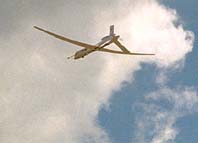
NASA and university scientists seek key to lightning
In 1752, Ben Franklin used a key on a kite string to study lightning. In 2002, NASA and university scientists devoted the month of August studying the same phenomena - this time using a remotely piloted aircraft soaring to heights of more than 50,000 feet. Both experiments were "firsts," offering new insight into dangerous weather disturbances and what fuels them. But today's technology - the high-flying aircraft packed with data-gathering instruments - enabled scientists conducting the Altus Cumulus Electrification Study (ACES) to study electrical storms without the risks Ben Franklin faced. "Much has changed in 250 years since Franklin proved lightning carries an electrical charge," said the study's principal investigator Dr. Richard Blakeslee, a NASA atmospheric scientist at the Global Hydrology and Climate Center in Huntsville, Ala. "Only recently have we acquired the ability to get an up-close, comprehensive look at storms without risking human contact with the energetic forces of nature." Based at the Naval Air Facility Key West in Florida, the storm-hunter research team in August flew 11 science missions, making 115 passes over the tops of thunderstorms to gather a multitude of data that will take months to fully analyze. One of the study's goals, Blakeslee said, was to test new aircraft technology and determine its potential for future meteorological applications. "A challenge weather researchers often face is getting continuous coverage of a single storm," he said. "An aircraft flying at 200 mph, for example, would provide only brief snapshots of storm activity sandwiched between long periods with no observations." To overcome these challenges, the research team used the General Atomics Aeronautical Systems, Inc. Altus II twin turbo uninhabited aerial vehicle, often called a UAV. Chosen for its slow flight speed of 70 to 100 knots (80 to 115 mph) and high-altitude flight (up to 65,000 feet); the Altus boasts a wing span of 55 feet and can monitor the storms on a near-continuous basis. "During this study, we made multiple storm passes in much shorter time periods than ever before, proving it is possible to make nearly continuous observations of severe weather," Blakeslee said. Evidence of this success was apparent Aug. 21, when the aircraft was able to stay over and around a single storm for one hour and 20 minutes. "For this one storm alone, we gathered data on more than 500 optical and electrical events produced by lightning flashes," he said. "We gathered a vast amount of scientific information throughout August, and each flight taught us something new about the aircraft's capabilities," said project manager Tony Kim of NASA's Marshall Space Flight Center in Huntsville. |
"The Aug. 21 flight was particularly noteworthy, because it was the study's longest-duration research flight. It lasted six hours and 32 minutes, enabling us to monitor four thunderstorms in succession. The final storm had cloud tops at 50,000 feet, an altitude that would have made studying this storm nearly impossible until recent advances in aviation." The results of this experiment help validate the use of remotely piloted aircraft for atmospheric research as well as scientific research in other areas. Part of NASA's Uninhabited Aerial Vehicle-based, science demonstration program, these flights acted as a proving ground for future uses, such as carrying Earth-viewing scientific payloads into environments where pilots would be exposed to potentially life-threatening hazards. Data acquired during the research flights included electric, magnetic and optical measurements, enabling the scientists to gauge elements such as lightning activity and the electrical environment in and around the storms. To complement this data, ground-based sensors gathered additional information, such as the lightning flash rate, amount of precipitation and speed of updrafts, while satellite imagery provided a view of the storms from high above. The team's forecasting abilities played a key role in the experiment's success, with each day's flight plan determined by predictions of what the day's weather would bring. "Because we had to reach the storms while they were forming, good, accurate storm forecasting was critical to our mission," said Blakeslee. "While we were often pleased with the forecasting information, there were still times when the predicted weather did not develop as forecast. One of our study's goals is to help improve weather prediction." By learning more about individual storms, scientists also hope to lend new insight into the global water and energy cycle and climate variability, while providing federal, state and local governments with new disaster-management information for use during severe storms, floods and wild fires. The Altus Cumulus Electrification Study is a collaboration among the Marshall Center, the University of Alabama in Huntsville, NASA's Goddard Space Flight Center in Greenbelt, Md., NASA's Ames Research Center at Moffett Field, Calif., Pennsylvania State University in University Park and General Atomics Aeronautical Systems, Inc. in San Diego. The mission is part of NASA's Earth Science Enterprise, a long-term research effort aimed at understanding how human-induced and natural changes affect our global environment, while providing practical societal benefits to America today. The Global Hydrology and Climate Center is one of seven science research centers at the National Space Science and Technology Center (NSSTC) in Huntsville. The NSSTC is a partnership with the Marshall Center, Alabama universities, industry and federal agencies. |






